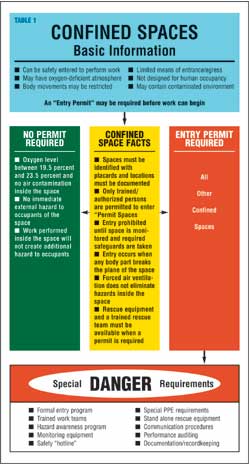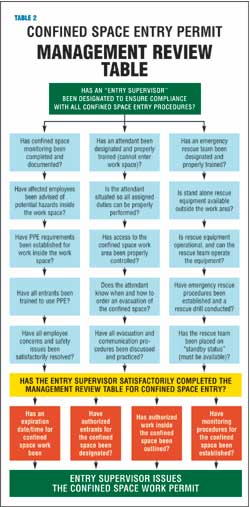Confined Space Entry, Part 1
Here's how to get your program started.
- By Stephen V. Magyar, Jr., MBA, CSP
- Feb 01, 2006
 SAD but true: In spite of all safety regulations and precautions, almost 500 deaths occurred in confined spaces during the past five years. Seventy-five percent of these deaths involved skilled workers who were cleaning, repairing, or performing routine maintenance. Oxygen deficiency, chemical exposure, entrapment, and engulfment were the leading causes.
SAD but true: In spite of all safety regulations and precautions, almost 500 deaths occurred in confined spaces during the past five years. Seventy-five percent of these deaths involved skilled workers who were cleaning, repairing, or performing routine maintenance. Oxygen deficiency, chemical exposure, entrapment, and engulfment were the leading causes.
Private industry had the highest rescuer death rate. In almost every case, failure to recognize or understand the potential hazard was the main error. Some famous last words of the entrants: "It smells okay--it must be safe"; "I can always hold my breath"; "I didn't know how to use the equipment"; and "I didn't realize it was a confined space."
These facts support the need for more effective communication and enforcement of safety requirements. Confined space work is serious business with death as the possible consequence of carelessness.
Organizations such as NIOSH, ANSI, OSHA, and others provide excellent guidelines for controlling accident risks. The actual development, implementation, and enforcement of required confined space work programs are management responsibilities mandated by law. Effective training, consistent safe work performance, and frequent work evaluations are the critical elements that must be developed.
The Human Element
When human behavior is involved, establishing a "fail-safe work ethic" is difficult. Human beings are not machines, and they make mistakes. Confined space work requires teamwork. Teamwork provides an opportunity to create a system of "checks and balances" among workers. Workers must understand that safe completion of the work requires a high level of cooperation. When the rules and procedures are engrained in the work routine and workers have ownership in the implementation process, a "fail-safe work ethic" can develop.
The safety culture that evolves is the only assurance that work will be accomplished safely. You must direct all confined space training efforts toward this objective.
The most basic element of a Confined Space Work Program is a management policy that:
1. Ensures identification of all confined spaces and associated hazards (placards and signs should be posted at all entrances).
2. Restricts entry into confined spaces without management approval (a work permit program must be established).
3. Selects confined space work teams, provides proper training, and posts the names of team members at the work site.
4. Provides required PPE and trains workers in its use.
5. Communicates all work requirements and confined space safety issues before work commences.
6. Provides "stand alone" rescue equipment and conducts rescue drills at least semi-annually.
7. Establishes safe exposure levels inside the confined space (oxygen, LEL, and toxicity), conducts atmospheric monitoring, records findings, and provides evacuation orders when safe exposure levels are exceeded.
8. Maintains appropriate records for all confined space work projects.
Communication
Communicating policy to the workforce must be accomplished with a well-balanced mixture of classroom training, practical application, and easily understood visual aids. Review applicable safety requirements (29 CFR 1910.146) and encourage discussion of personal experiences in confined space environments.
Table 1 lists the basic characteristics of confined spaces, provides details about permit and non-permit work requirements, and offers several specific confined space rules.
A work permit is not required for confined space work when the following conditions are met:
1. Oxygen level inside the space is between 19.5 percent and 23.5 percent, and there is no contamination.
2. There is no immediate external hazard to the occupants inside the confined space.
3. Work performed inside the space does not create additional hazards to the occupants.
When work is performed in a confined space under any other condition, a formal confined space entry program that includes trained work teams must be implemented. Team members must be assigned responsibilities that will ensure safe work during the life of the permit.
In Table 1, the green background indicates it is safe to proceed with work. Yellow indicates caution. Red indicates danger, or stop work until specific safety requirements are met.

Required team members include:
1. Entry Supervisor, who must issue a work permit
2. Attendant, who must enforce the established permit
3. Entrant, who must enter the work space to perform work
4. Monitor, who must periodically evaluate the work atmosphere
5. Rescue team, which must be readily available in the event of an emergency
6. Coordinating the confined space entry program should be a certified safety professional or other individual who is knowledgeable in confined space entry hazards, safety requirements, and training methods.
Other specific requirements include:
1. Work permit that must be completed, signed, and posted at the work site by the Entry Supervisor
2. Stand alone rescue equipment must be immediately available, and a trained rescue team must be available on a "standby" basis
3. Atmospheric monitoring must be conducted, and results must be posted at the work site
4. All connecting pipelines and energy sources that could create a hazard inside the work space must be isolated.
Table 2 provides a flow chart/checklist that must be reviewed by the Entry Supervisor before a work permit is issued. The supervisor's principal responsibilities are outlined in the unshaded blocks and the red blocks. All questions must be answered "yes." Yellow indicates caution; red indicates danger or stop work until special requirements are met; and green indicates it is safe to proceed with work. Use of this checklist will ensure a standardized evaluation of necessary safety procedures before a permit is issued.

Work Permits, Stoppages
Confined space work permits and attachment forms provide a description of the work location, work period, and special permit requirements. The attachments list the personnel included on the entry team and the monitoring results. This information must be reviewed with all team members and posted at the work site. To view examples of the forms, click on the following: Sample work permit, Attachment "A" for work personnel, or Attachment "B" for monitoring results.
All safety issues and concerns must be resolved before work begins. The attendant serves as the "traffic cop" and must be located so he/she can properly monitor compliance with the work order. Procedures for stopping work must be established, and the attendant must have the authority to stop work when permit requirements are not followed.
Violations that require immediate evacuation of the space include:
1. Unauthorized entry of personnel
2. External hazard that could cause safety concerns inside the space and/or make enforcement of the work order difficult
3. Introduction/development of new hazards inside the space
4. Rescue team is "out to lunch"
Whenever a work stoppage is ordered, all work operations must cease immediately, and all occupants of the confined space must leave the work area. The work permit must be cancelled, and you must conduct a complete evaluation of "what went wrong." There should be no finger-pointing, and all entry team members should participate in the investigation.
Required corrective action must be identified and implemented before a new work permit is issued. Work stoppages indicate a major failure that, if not properly addressed, could cause serious consequences. There should be no "guesswork" associated with confined space work. When work permit procedures are not followed, all work stops.
The Entry Supervisor is the only individual who can complete a work permit and authorize work inside a confined space. When workers are properly trained and the work permit is posted, work can begin. Until these requirements are completed, any work performed inside a "Permit Required Confined Space" is illegal, and it places workers at extreme risk.
This article, the first in a five-part series, appeared in the February 2006 issue of Occupational Health & Safety.
References
1. American National Standards Institute, Safety Requirements For Working In Tanks and Other Confined Spaces, Z117.1.
2. Bender, Thomas R., et al., Worker Deaths in Confined Spaces: A Summary of Surveillance Findings and Investigative Case Reports, U.S. Department of Health and Human Services, Publication No. 94-103.
3. National Institute for Occupational Safety and Health, Criteria for a Recommended Standard: Working in Confined Spaces (Publication No. 80-106).
4. National Institute for Occupational Safety and Health, A Guide to Safety in Confined Spaces (Publication No. 87-113).
5. National Safety Council, Confined Space Entry Control System for R&D Operations, Data Sheet No. 704.
6. U.S. Department of Labor, Code of Federal Regulations, Part 1910.146, Permit Required Confined Spaces.
This article originally appeared in the February 2006 issue of Occupational Health & Safety.